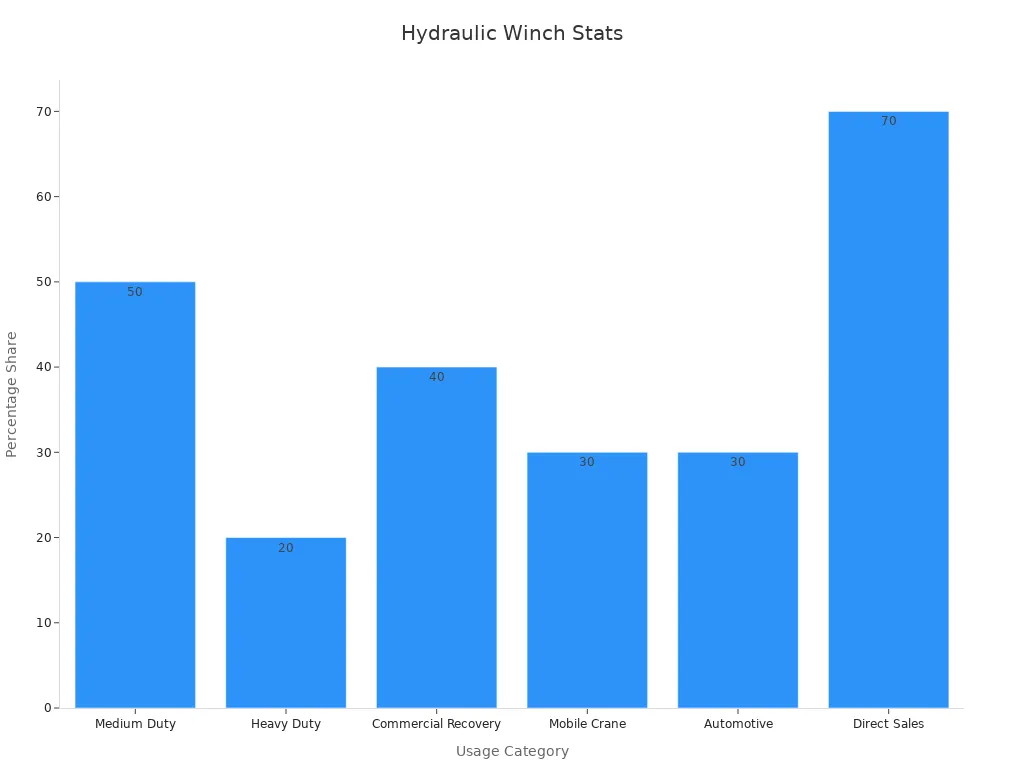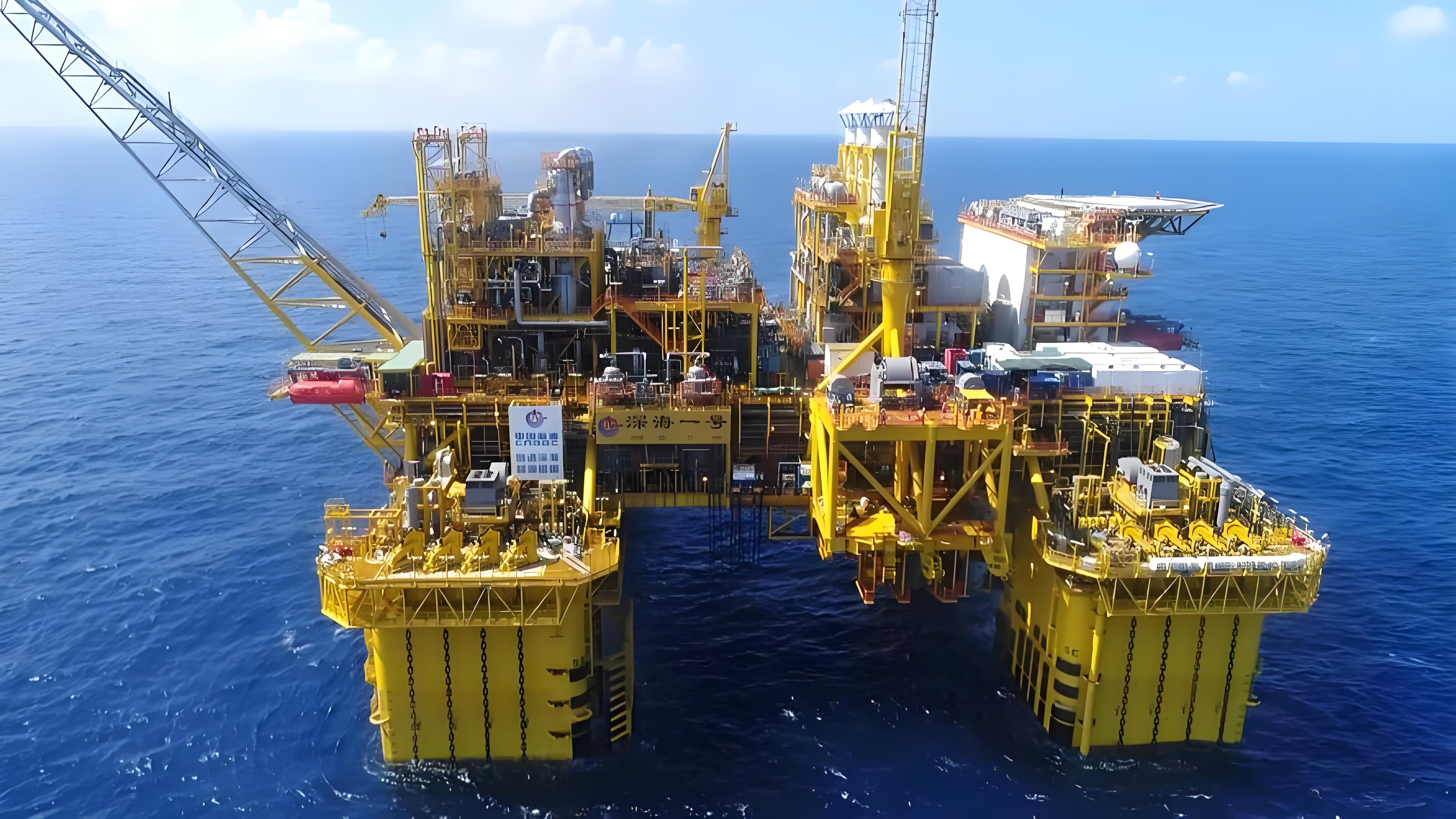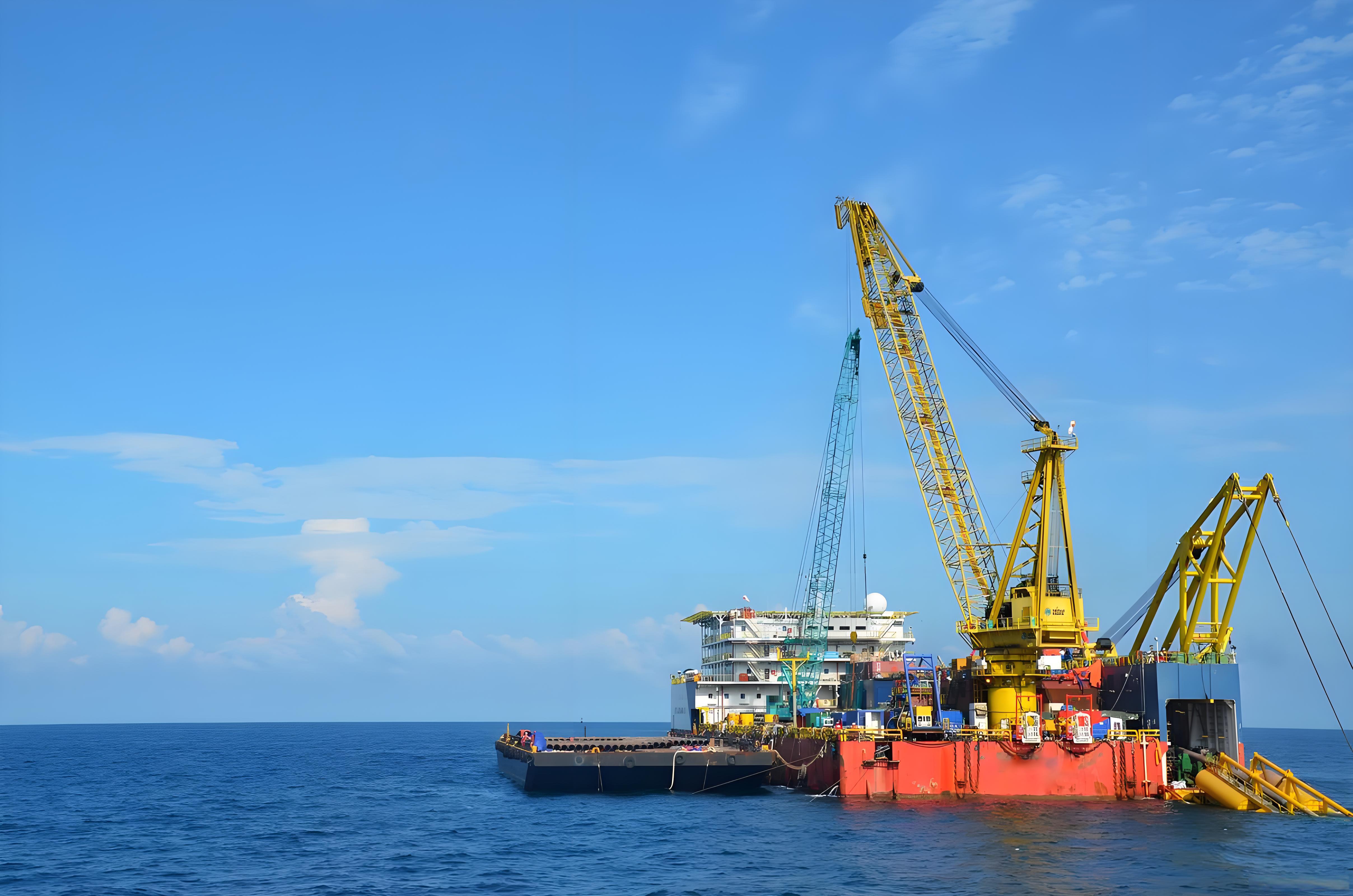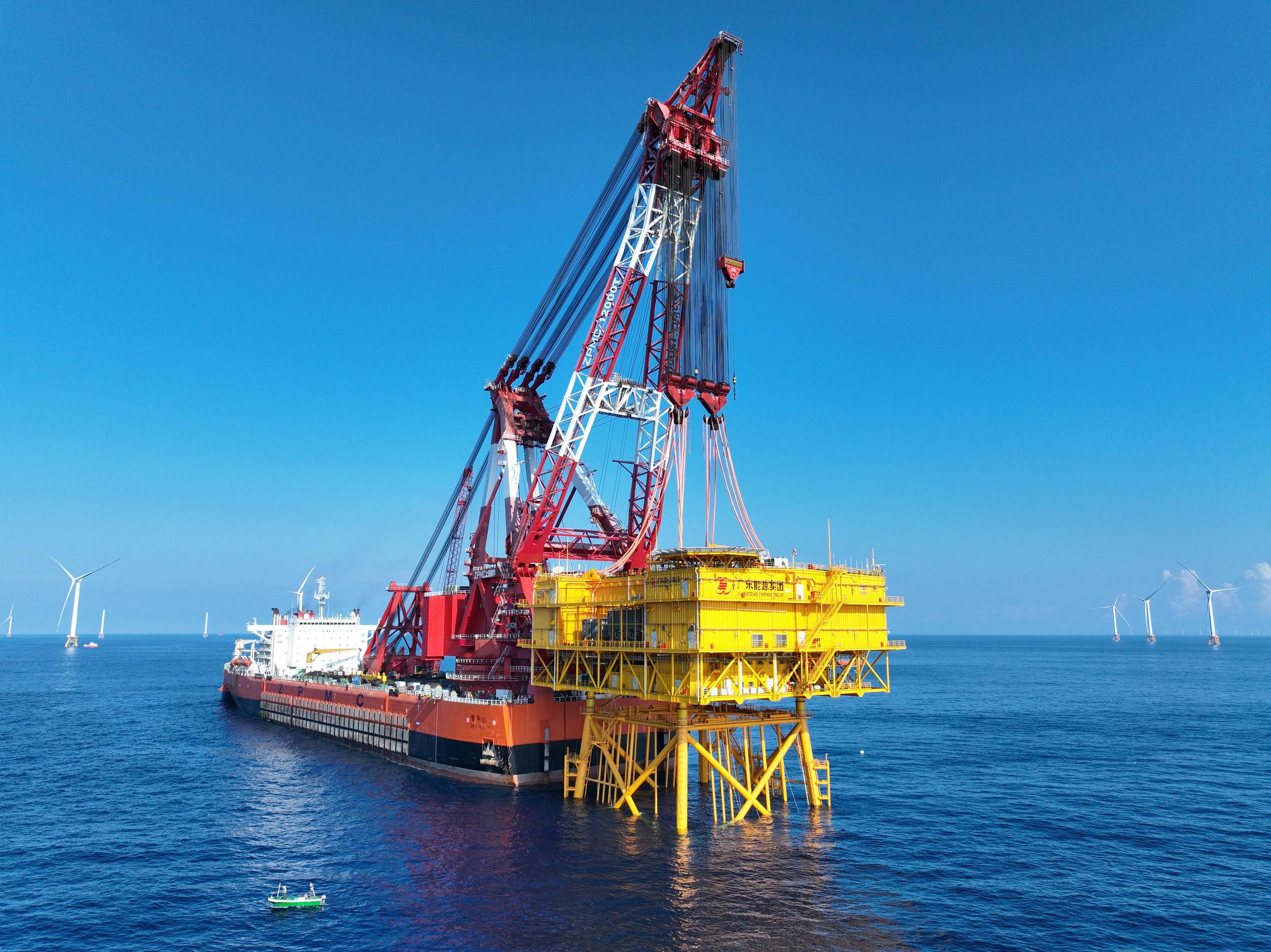How Hydraulic Winches Work and Their Applications
A Hydraulic Winch uses pressurized fluid to deliver strong pulling or lifting force for heavy loads. Industries such as construction and marine rely on these systems for efficiency and power.

Key Takeaways
- Hydraulic winches use pressurized fluid to generate strong pulling power, making them ideal for heavy lifting in industries like construction, marine, and mining.
- These winches offer high durability, precise control, and can operate in extreme conditions, thanks to components like hydraulic motors, gearboxes, and advanced safety systems.
- Choosing hydraulic winches over electric ones depends on the need for continuous heavy-duty use, power availability, and environmental conditions, with hydraulic winches excelling in tough and demanding tasks.
Hydraulic Winch Operation and Components
What Is a Hydraulic Winch
A hydraulic winch is a motorized device that uses hydraulic power to pull or lift heavy loads. This equipment finds widespread use in industries such as marine, construction, mining, and automotive. The system relies on pressurized hydraulic fluid to generate mechanical energy, which drives a drum to wind or unwind a cable or rope. Hydraulic winches operate based on Pascal’s law, which states that pressure applied to a confined fluid transmits equally in all directions. This principle allows the winch to deliver high torque and precise control, even under demanding conditions.
Hydraulic winches come in several types, each designed for specific applications:
- Single drum winches handle general lifting and pulling tasks.
- Double drum winches allow for simultaneous operations.
- Planetary winches use planetary gears to multiply torque, making them suitable for extremely heavy loads.
- Capstan winches provide continuous pulling force, often used for mooring or towing.
- Offshore winches are engineered to withstand harsh marine environments.
Recent market research confirms that hydraulic winches deliver robust performance and high load-carrying capacity. Their durability and ability to function under extreme conditions make them a preferred choice for heavy-duty mining, oil & gas, and marine operations. Technological advancements, such as remote control and automatic braking, further enhance their operational efficiency and safety.
Key Components of a Hydraulic Winch
A hydraulic winch consists of several essential components, each contributing to its reliable operation:
- Hydraulic Motor: Converts pressurized hydraulic oil into rotational mechanical energy.
- Reduction Gear (Gearbox): Increases torque and reduces speed, allowing the winch to handle heavy loads efficiently.
- Drum: The cylindrical component that winds or unwinds the cable or rope.
- Brake System: Secures the drum when the winch stops, ensuring safety during operation.
- Control System: Includes valves that regulate pressure, flow, and direction of hydraulic oil.
- Auxiliary Parts: Oil storage tanks, filters, pipelines, seals, and control instruments maintain oil quality and system integrity.
The reliability of these components has been validated through advanced engineering methods. For example, finite element analysis and experimental validation have shown that modern winch systems accurately predict stress distributions and ensure safety. Reliability analysis using statistical models helps predict failure probabilities and optimize maintenance schedules, further enhancing operational availability.
Component |
Function |
Reliability Insights |
|---|---|---|
| Hydraulic Motor | Converts hydraulic energy to mechanical power | High starting torque and efficiency |
| Gearbox | Multiplies torque, reduces speed | Planetary gears improve load handling |
| Drum | Winds/unwinds cable or rope | Frequent use requires regular inspection |
| Brake System | Secures drum, prevents slippage | Automatic brakes increase safety |
| Control Valves | Regulate oil pressure, flow, and direction | Load-sensing and fail-safe features enhance reliability |
| Auxiliary Parts | Maintain oil quality and system integrity | Proper filtration and sealing extend component life |
How a Hydraulic Winch Works Step by Step
The operation of a hydraulic winch follows a systematic sequence:
- The hydraulic pump draws mechanical energy from a prime mover, such as an engine, and converts it into hydraulic energy by pressurizing oil.
- Pressurized oil flows through control valves, which regulate the pressure, flow rate, and direction of the hydraulic fluid.
- The hydraulic motor receives the pressurized oil and transforms the hydraulic energy into rotational motion.
- The reduction gearbox multiplies the torque produced by the motor and reduces the rotational speed, optimizing the force applied to the drum.
- The drum rotates, winding or unwinding the cable or rope to move or lift the load.
- The brake system engages automatically or manually to secure the drum when the winch stops, preventing accidental movement.
- Auxiliary components, such as filters and oil reservoirs, ensure the hydraulic fluid remains clean and at the correct level, supporting smooth operation.
Tip: Advanced hydraulic winches often feature remote control, automatic braking, and load monitoring systems. These technologies improve safety and operational efficiency, especially in hazardous or high-load environments.
Industry forecasts highlight the growing adoption of hydraulic winches in sectors that demand superior power and control. The integration of automated control systems and remote diagnostics supports their critical role in infrastructure, oil & gas, and marine applications.
Hydraulic Winch vs. Electric Winch
Advantages of Hydraulic Winches
Hydraulic winches deliver exceptional performance in demanding environments. Their motors provide superior torque and reliability, especially in harsh conditions where electric winches may struggle. Users benefit from technical advantages such as up to 95% efficiency and a 25% longer lifespan due to reinforced materials. Hydraulic winches operate across a wide temperature range, from -40°F to 300°F, making them suitable for extreme climates.
- Field tests show a 30% reduction in downtime when using hydraulic systems with hydraulic gear pumps.
- A maritime logistics company reported 18% fuel savings, 22% faster anchor retrieval during storms, and zero motor failures over three years across 12 vessels.
- Tunnel boring projects have run hydraulic gear pumps continuously for 8,000 hours without performance loss.
These results highlight the durability and operational efficiency of hydraulic winches in real-world applications.
Disadvantages of Hydraulic Winches
Hydraulic winches face challenges in environments with complex motion, such as marine vessels. The six degrees of freedom in vessel movement can affect winch accuracy and increase the risk of cable breakage. Operators often require active heave compensation systems to maintain control. The complexity of hydraulic control systems, including load sensing and overcentre valves, can make precise speed control difficult. Research in the offshore oil and gas industry also notes that hydraulic winches may have lower efficiency compared to electric winches. Environmental concerns and energy consumption have led some sectors to consider high-efficiency electric alternatives.
Choosing Between Hydraulic and Electric Winches
Selecting the right winch depends on several factors. Electric winches offer durability, cost-effectiveness, and precise speed control, making them suitable for lighter loads and applications requiring accuracy. However, they are not designed for continuous operation due to the risk of motor overheating. Hydraulic winches require a hydraulic power supply but excel in heavy-duty, continuous pulling tasks and extreme environments. In marine and industrial settings, hydraulic winches provide robust power and durability. Decision-makers should consider power source availability, load capacity, operational demands, and environmental conditions when choosing between these two options.
Hydraulic Winch Applications
Industrial and Construction Uses
Hydraulic winches play a vital role in industrial and construction settings. They generate immense force and torque, making it possible to pull, lift, or push heavy loads with minimal effort. Many industries, including automotive and manufacturing, rely on these winches for tasks such as moving machinery, positioning steel beams, and handling large construction materials.
- Hydraulic winches offer greater power, speed, and efficiency than electric winches, which allows them to handle heavier loads.
- Consistent power output leads to smoother operation and reduces wear on components.
- Their compact size and ability to function in extreme temperatures make them ideal for tight spaces and harsh environments.
- Key components like hydraulic pumps and cylinders provide reliable and precise force control, which is essential for demanding tasks.
- Lower maintenance needs and fewer moving parts help reduce operational costs.
Marine and Offshore Applications
Hydraulic winches deliver exceptional lifting capacity and smooth operation in harsh marine environments. Advanced control systems allow operators to make precise adjustments and monitor real-time data. Built-in safety features, such as overload protection and fail-safe mechanisms, ensure safe operation during critical offshore tasks. Modular designs enable customization of line speeds, pulling limits, and drum sizes to meet specific project requirements.
Hydraulic winches in offshore oil and gas environments use corrosion-resistant materials and coatings, such as marine-grade epoxy paints and stainless steel components. Explosion-proof technology prevents ignition in hazardous atmospheres. Hydraulic fluids remain stable under high pressure and wide temperature ranges, ensuring reliable performance in subsea conditions. These technical adaptations validate the suitability of hydraulic winches for demanding marine and offshore applications.
Rescue and Specialized Fields
Emergency response teams and specialized industries depend on hydraulic winches for their reliability and strength. Firefighters use them to clear debris or move vehicles during rescue operations. Utility companies deploy hydraulic winches to lift heavy equipment or tension cables during repairs. In mining and tunneling, hydraulic winches help move large machinery and support critical safety operations. Their ability to operate continuously and withstand extreme conditions makes them a trusted tool in high-stakes environments.
Hydraulic winches deliver unmatched pulling power and continuous operation, even in submerged or hazardous environments. Operators benefit from advanced safety features, such as real-time load monitoring and emergency shutdown systems. Rugged construction and precise calibration ensure long-term reliability, making these systems a trusted solution for demanding applications.
FAQ
What maintenance does a hydraulic winch require?
Regularly check oil levels, inspect hoses for leaks, and clean filters. Lubricate moving parts. Schedule professional inspections for optimal performance.
Can hydraulic winches operate underwater?
Yes. Many hydraulic winches feature sealed motors and corrosion-resistant materials. These features allow reliable operation in submerged or marine environments.
How does a hydraulic winch handle overload situations?
Operators rely on built-in overload protection systems. These systems automatically stop the winch or alert users to prevent equipment damage and ensure safety.


